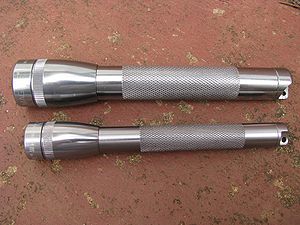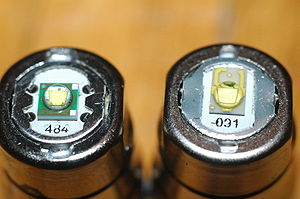Difference between revisions of "Mag Instrument"
(add picture of LED's) |
(add picture of Minimags) |
||
| Line 1: | Line 1: | ||
Mag Instrument, Inc., is the manufacturer of the legendary Maglite flashlight. The company was incorporated by Anthony Maglica in 1974 and began producing the first Maglites in 1979. The company is based in Ontario, California | [[File:Maglites.jpg|thumb|300px|Mini Maglites (2xAA and 2xAAA) with pewter finish]]Mag Instrument, Inc., is the manufacturer of the legendary Maglite flashlight. The company was incorporated by Anthony Maglica in 1974 and began producing the first Maglites in 1979. The company is based in Ontario, California | ||
The '''Maglite''' (also spelled Mag-Lite ) was introduced in 1979. It is constructed principally of anodized 6061 aluminum, sometimes referred to as aircraft aluminum. Maglites are known for their variable-focus beam, water resistant pushbutton switch and durability. They are available in a wide variety of colors and are a favorite of collectors. | The '''Maglite''' (also spelled Mag-Lite ) was introduced in 1979. It is constructed principally of anodized 6061 aluminum, sometimes referred to as aircraft aluminum. Maglites are known for their variable-focus beam, water resistant pushbutton switch and durability. They are available in a wide variety of colors and are a favorite of collectors. | ||
Revision as of 15:15, 23 January 2011
Mag Instrument, Inc., is the manufacturer of the legendary Maglite flashlight. The company was incorporated by Anthony Maglica in 1974 and began producing the first Maglites in 1979. The company is based in Ontario, California
The Maglite (also spelled Mag-Lite ) was introduced in 1979. It is constructed principally of anodized 6061 aluminum, sometimes referred to as aircraft aluminum. Maglites are known for their variable-focus beam, water resistant pushbutton switch and durability. They are available in a wide variety of colors and are a favorite of collectors.
Lights
C and D Maglite
Incandescent bulbs are manufactured for different numbers of batteries, for example a 3-cell light will blow out a bulb made for 2 cells. Maglites are available with 2, 3, 4, 5, or 6 D-size cells and 2, 3, or 4 C-size cells. A 7D light as well as 5C, 6C, and 7C lights were produced but are no longer made. The stock incandescent bulb is krypton, but xenon replacements are available. Maglite uses ANSI/NEMA FL-1 ratings for output, so all lumens here are ANSI lumens.
- 1979: C and D cell battery models are put on the market; targeted to the public safety and industrial sectors
- May 2006: 2D and 3D Maglite LED's introduced using Luxeon III LED with a bonus krypton bulb in the tail cap.
- January 2009: 2D Maglites now feature Luxeon Rebel 090 LED. LED is not replaceable. Max output is 114 lumens.
- April 2009: 3D LED Maglites now have Rebel 091 LED and are brighter than 2D. Output is 104 lumens.
- November 2010: 3D LED Maglites begin to appear with Cree XP-E LED's, labeled "Brighter LED" and now show 131 lumens.<REF>CPF Thread with ANSI Output</REF><REF>Initial CPF thread with pictures</REF>
AA Mini Maglite
- 1984: First Mini Maglite introduced with 2xAA batteries, side switch replaced by twisting head (loosen for on), including variable focus, extra bulb in tail cap, and candle mode ability. The incandescent MiniMag has output of 14 lumens.
- August 2006: 2xAA and 3xAA Maglite LED's introduced, lacking lanyard attachment on tail
- January 2009: 2xAA Multimode Mini Maglite LED (High, Low, Slow Flash, SOS), using Luxeon Rebel 090
- November 2009: 2xAA Multimode Mini Maglite LED now has lanyard attachment similar to incandescent version.
AAA Mini Maglites
- 1987: First 2xAAA Mini Maglite introduced, just like 2xAA Mini Maglite, but smaller.
Maglite Solitaire
- 1988: First 1xAAA Maglite Solitaire introduced. Maximum output is 2 lumens.
MagCharger
- 1982: MagCharger: a larger more expensive model popular with public safety and emergency-services personnel. This light is much brighter than typical Maglites, and uses a rechargeable NiCad battery pack.
- 2008: MagCharger battery upgraded to NiMH battery
XL100
- February 2010: 3xAAA XL100 introduced with Rebel 091 LED and variable brightness and motion-activated mode switching. Maximum output is 83 lumens. CPF Review web page
XL50
- November 2010: 3xAAA XL50 is 3 modes with 104 lumens. Simpler interface than the XL100. Review: CPF web page
Summary Table
| Light | Batteries | Lamp | Max Output (lumens) |
Throw (m) |
|---|---|---|---|---|
| Solitaire | 1xAAA | Incan | 2 | 20 |
| MiniMaglite | 2xAAA | Incan | 9 | 31 |
| MiniMaglite | 2xAA | Xenon | 14 | 96 |
| MiniMaglite | 2xAA | Rebel | 69 | 101 |
| Maglite | 2xD | Krypton | 19 | 229 |
| Maglite | 2xD | Rebel | 114 | 298 |
| Maglite | 3xD | Krypton | 14 | 96 |
| Maglite | 3xD | Rebel | 104 | 289 |
| Maglite | 3xD | XP-E | 131 | 364 |
| Maglite | 4xD | Krypton | 72 | 265 |
| Maglite | 6xD | Krypton | 136 | 295 |
| XL50 | 3xAAA | Rebel | 104 | 145 |
| XL100 | 3xAAA | Rebel | 83 | 134 |
Variants
Clones
Due to the popularity of the Maglite, many companies copied the design. However, Mag Instrument was successful in protecting its design and won settlements from Brinkmann, Streamlight, and others.
The 2xAA Mini Maglite in four variations
Maglites are often available in colors such as black, silver, blue, and red. They have also been available in a very large number of other colors, textures, and formats, including:
- Pink 2xAA Mini Maglite
- No- knurl Pink 2xAA Mini Maglite
- No-knurl Pewter 2xAA Mini Maglite
- NASCAR 2xAA Mini Maglite
- Patriotic 2xAA Mini Maglite (FlagLite)
- 2xAAA Mini Maglite for Military and Law Enforcement
- Jade Colored D-cell models
- Camouflage (2 AA and 3D Sizes)
For a longer list, see this CPF post
Accessories
Accessories manufactured by Mag Instrument Co. for the Maglite include belt holsters, light clamps, anti-roll collars, colored and glass lenses, attachable fiber optics extensions, higher-powered incandescent bulbs, and LED conversion modules.
Non-LED Maglites are equipped with a spare light bulb encased in the tailcap. LED bulbs have a significantly longer lifetime, and thus generally do not need to be replaced. LED Maglites do not include a spare LED, but some include a spare conventional bulb.
Mods
Maglites are one of the most widely used hosts for modifications. A summary of available mods is available in a cpf thread, and drop-in manufacturers include:
- Malkoff Devices
- 3D Direct Drive SSC P7 Mod Lots of pictures,step-by-step
- 2D ROP Mod Has links to parts needed to convert a 2D Mag to a super bright li-ion powered ROP light. If you live outside the USA, the bulbs will be hard to find, or extremely expensive to buy.
Xenon upgrades
Brighter light than stock bulb.
Led upgrades
Sold by Maglite, and also by third parties (Terralux, Nite Ize). Easy to drop in a new LED (and maybe a new reflector). The reliability of third part kits varies. The 3 Watt LEDs produce significant increases in light over stock bulks, but less than the latest LED Mags. 3 cell maglites work best with LED sources, because the voltage (3*1.2v=3.6v) does not need altering with circuitry.
A very good general purpose drop-in replacement for the incandescent bulb is the 36 LED dropin tested here. http://budgetlightforum.cz.cc/node/467 It is good for around 400 lumens on 6 cells, about 300 on two D cells. It will produce a lot of light for a very long time. It is best with more than three cells, but wants six for best output.
Upgrade combinations
A sensible combination for the 3 cell C/D range, is 8000/1000 MAh Ni-Mh batteries, and a 3 Watt LED, for long life, and high brightness. Given the high cost of the rechargeable maglite, these parts plus a quality universal charger, can be purchased for a similar price.
Sources
<references/>

